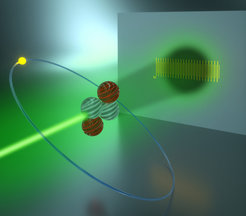How big is the alpha particle? Laser spectroscopy provides new results with record precision
The size of the alpha particle, the nucleus of the helium atom, has been measured more accurately than ever before. Results now indicate a size 1.67824(83) femtometers, which is 4.8 times more precise than previous measurements. The researchers used laser spectroscopy of exotic helium ions, where the electron is replaced by a 200 times heavier muon. The experiment, reported on January 28, 2021 in Nature, has been performed by an international collaboration (CREMA) using the world’s strongest source of low-energy muons at the Paul Scherrer Institute in Switzerland.

(source: Ryan Allen MS, Second Bay Studios, Santa Barbara, CA, USA)
CREMA has many ties to the Laser Spectroscopy Division at the Max-Planck-Institute of Quantum Optics in Garching. The spokesman, Randolf Pohl, now Professor at the University of Mainz, has been a staff scientist at the MPQ during the time of the experiment, and the first author Julian Krauth, who reported on this experiment as part of his doctoral thesis with Professor Hänsch, has played a central role in coordinating the theoretical interpretation of the experimental data. Other former MPQ doctoral students in the collaboration include Aldo Antognini, Mark Diepold, and Tobias Nebel.
The charge radius of simple nuclei provide an important testing ground for nuclear theory. The alpha particle is the smallest atomic nucleus after the proton, the nucleus of the hydrogen atom. Even though the alpha particle consists of two protons and two neutrons, it is even smaller than the deuteron, which contains only one proton and one neutron. Shifts of atomic energy levels due to the finite size of the nucleus are dramatically magnified in muonic atoms, so that laser spectroscopy can be used to investigate the nuclear structure with high precision. An accurate measurement of the alpha particle charge radius has gained much interest since the discovery of the proton radius puzzle, where laser spectroscopy of muonic hydrogen and ordinary hydrogen gave differing results for the charge radius of the proton.
The new measurement of the 2S-2P Lamb shift resonance in muonic helium-4 ions by laser spectroscopy yields a root-mean-square charge radius of the α particle of 1.67824(83) femtometers, in excellent agreement with the value from electron scattering, but by a factor of 4.8 more precise. It provides a benchmark for few-nucleon theories, lattice quantum chromodynamics and electron scattering. This agreement also constrains several beyond-standard-model theories proposed to explain the proton-radius puzzle in line with recent determinations of the proton charge radius, and establishes spectroscopy of light muonic atoms and ions as a precise tool for studies of nuclear properties.
“I have always been fascinated by laser spectroscopy of exotic atoms, such as muonic helium, because we can test the laws of quantum physics under conditions that have not been explored before. In the future, precision spectroscopic measurements at low energies may well lead to fundamental discoveries, such as new physics beyond the standard model,” explains Professor Hänsch.
(TH)












